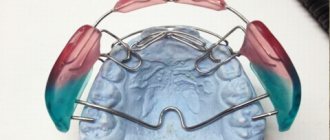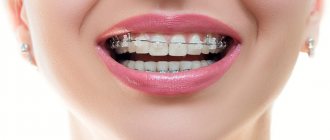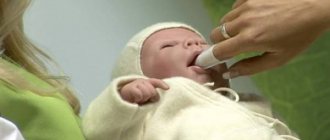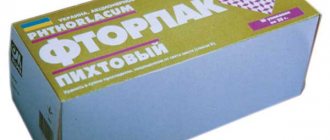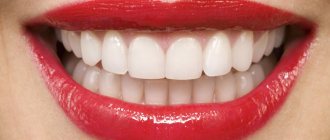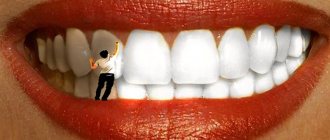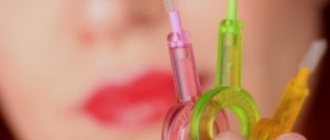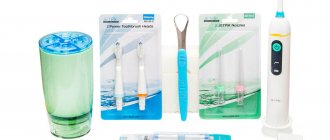5525
Orthodontic pathologies are a fairly common occurrence. Their treatment is carried out using various fixed and removable devices.
It is much more effective to carry out medical intervention to correct such defects in childhood, while the dental system is not yet fully formed and can be easily corrected.
One such device is the T4K trainer, manufactured by Myofunctional Research Co.
What is the device?
A pre-orthodontic trainer is one of the types of elastopositioners that are used in orthodontics .
It is of greatest relevance for the correction and correction of various disorders of the maxillofacial structure and development of children, since its work is aimed largely at normalizing muscle activity.
When used correctly and in a timely manner, this design makes it possible to eliminate and eliminate the multiple effects of harmful childhood habits such as thumb sucking, poor articulation or swallowing.
All this despite the fact that the muscular frame of the face is loose and contributes to the improper development of the dental system and adjacent organs, for example, ENT organs.
Design features
The design of the device is simple. It is a two-jaw mouthguard, which is essentially a kind of cover for the dentition.
All components of the device perform a specific function, which, together with others, helps to completely correct the situation with malocclusion at an early age.
The T4K trainer provides:
- recesses for teeth;
- labial (labial) arches from the outside;
- special tongue;
- on the inside - a tongue stop;
- lip bumper.
How to correct a distal bite, read in a new publication.
We will tell you here what an orthodontist treats. What problems does a dentist in this specialty solve?
In the link we will talk about how effective myogymnastics is for distal occlusion.
Varieties
The device has two varieties, which are completely identical in their structure and design, but differ in material parameters.
- Initial .
Painted in light blue, the T4K Trainer is soft and flexible. Its flexibility ensures rapid adaptation to most pronounced changes in the dentition, manifested in non-closing of the jaws, that is, disocclusion. The main purpose is to eliminate myofunctional problems (associated with improper functioning of the facial and cranial muscles) and bad habits, including mouth breathing. - Final. Painted in pink (red) color, more rigid. In many ways, its action is carried out on the principle of using wire arcs.
It is intended as the second stage of treatment, immediately following the use of the first version of the trainer.In some cases, when the severity of disocclusion is minimal, the doctor may prescribe wearing a pink trainer at the first stage.
Characteristics
Both types of T4K pre-orthodontic trainer are made of elastic material. For this purpose, silicone with color additives is used for easy identification of models .
The only difference is that a harder silicone is used to make the final trainer.
The material is hypoallergenic, which is especially important when using it to treat children. Silicone has so-called shape memory. This allows the trainer to quickly adapt to the individual characteristics of the patient.
This makes it possible to use T4K in a universal size , rather than wait a significant amount of time for individual production, since the adjustment is minimal and takes a minimum of time.
Also, the material, despite its relative flexibility and elasticity, has a large margin of strength. This makes it possible to carry out treatment using only one trainer, rather than replacing it, such as mouth guards.
Advantages and disadvantages
The advantages of T4K trainers are numerous:
- Strength and durability.
- Hypoallergenic.
- Comfortable and easy to wear.
- Almost complete absence of discomfort in children when wearing.
- Can be used to correct most malocclusions.
- Relatively short treatment period.
- Ensuring the child’s psychological comfort, since the device is not worn during games and communication with peers, accordingly, the correction of violations occurs unnoticed by others and the child is spared ridicule.
- Two small holes in the front section of the device make it possible to continue use even in cases of severe rhinitis.
disadvantages . The main one is to correct only relatively uncomplicated cases when there is no need for precise movement of each tooth .
In addition, the disadvantage is that for the success of treatment it is necessary to strictly follow the recommendations and maintain accuracy in wearing time .
When used by children, this can sometimes be quite a difficult task.
Types of models
For the T4k orthodontic trainer to work, two stages of treatment are required, during which the aligners are changed.
At the first stage, the baby needs a trainer made in blue. This
construction made of softer material. Due to this, the trainer can easily “adapt” to a specific anomaly (malocclusion or dentition development) and, acting on it, gradually eliminates the problem.
At the second stage of treatment, a more rigid tray of a pink (red) shade is required. It is intended to consolidate the obtained result. Duration of use – from 3 to 6 months.
Before purchasing a t4k trainer, installing it or replacing it with a new one, you need to consult an orthodontist.
And remember that the treatment must be consistent or continuous, otherwise all the work after a few weeks will be in vain and you will have to start over.
Who is it suitable for?
T4K trainers have a strictly defined area of application. It is intended to treat children aged 5 to 12 years .
Indications
- Crowding of teeth in the central part of the lower jaw.
- Deep bite.
- Open bite (central area).
- Engle class II (subclasses 1, 2).
- Angle's I class - crowding.
- Mild Angle class III.
- Various bad habits: improper swallowing, speech problems, mouth breathing, thumb sucking.
- Unnatural position of the lower jaw.
Contraindications
- Pronounced Angle class III.
- Pathological nasal congestion (obstruction of the nasal passages).
- Pronounced conflict between children and parents.
- Cross bite (lateral parts of the jaws).
Advantages of removable structures
The importance of trainers in orthodontics is difficult to adequately assess. After all, they have many positive properties and advantages, namely:
- increased comfort during operation;
- high levels of strength and, accordingly, durability;
- hypoallergenic material;
- wide range of indications for use. Have a positive effect even with complex defects;
- speed of addiction;
- relatively short period of complete bite correction;
- absence of psychological trauma during operation . Thanks to the ability to wear the design only at home, the child will avoid negative ridicule from peers.
If a child often suffers from inflammatory processes of the nasal mucosa, the design manufacturers have provided for this nuance by making two small holes in the trainer.
Therefore, there is no need to suspend the use of the device if nasal breathing is limited.
See photos of cracks in the tongue, the reasons for their appearance and methods of getting rid of the pathology. This article contains all the most interesting things about modern methods of straightening teeth without braces.
Follow the link https://dr-zubov.ru/lechenie/yazyk-l/krasnye-pyatna-prichiny-i-reshenie.html if you are interested in what could cause a smooth red spot on the tongue.
What effect does it have?
Each structural element performs a specific function, which is necessary to correct the bite as a whole.
- Labial arches in T4K are somewhat different from similar devices for adults - they are less high. This element helps the fangs take the correct position in the dentition, especially when they erupt.
- The slightly shortened design of the children's appliance not only provides comfort and ease of wearing, but also provides support for the seventh teeth in a row.
This ensures their correct position in relation not only to neighboring teeth, but also to antagonists located on the opposite jaw. - A special tongue helps the child to correctly position his own tongue, especially its tip.
It is the position of the tongue in the mouth at the stage of formation of the dental system that can affect the location and growth of teeth. Here the tongue is a protruding part that constantly reminds the baby of itself, as it touches the tongue. Accordingly, this element is active. - The recesses provided by the design position the teeth in the correct position - a row. They work, despite the relatively soft material, like wire arches used in orthodontics.
- Labial arches allow you to involuntarily relax individual muscles that are tense in case of malocclusion. Relieving excess stress allows the teeth to return to their normal position.
- Separately, it should be noted small protrusions on the inside of the labial arches , which exert a certain (minimal, but sufficient) pressure on uneven front teeth, thereby provoking a correction of their position.
The entire structure provides overall bite correction. This is facilitated not only by fixation of the dentition, but also by the anatomically correct and natural position of the tongue, limitation of its movement, stimulation of normal breathing through the nose and marginal closure.
How to choose a treatment method for open bite in children? What are the methods used?
In the next article we will discuss which orthodontic trainers are used for children.
Read the link https://www.vash-dentist.ru/ortodontiya/prikus/perekrestnyiy-opisanie-patologii-i-sposobyi-lecheniya.html about the features of correcting crossbite at different ages.
Bite defects in children
Children and teenagers often develop malocclusion, which is caused by incorrect positioning of the tongue and lips. If the baby is raised on artificial nutrition or has used a pacifier for too long, a malocclusion is guaranteed. Incorrect position of the lips and tongue is caused by the habit of putting the thumb in the mouth during sleep or during the day, and the habit of pulling various objects into the mouth.
Parents must promptly recognize the onset of malocclusion in order to take timely measures. Signs of developing pathology are:
- irregular face oval;
- separation of teeth in different parts of the jaw;
- parted lips;
- protruding tongue forward when swallowing;
- pathologies of teething;
- grimaces.
An irregular oval of the face can be noticed immediately: the face takes on an elongated shape or the lower part looks shortened. In profile, the head looks convex or concave. Often a child develops asymmetry: one part of the face visually looks larger than the other. The cause of the deformation may be a jaw that is too small or too large, or an abnormal inclination of the teeth.
How to determine the separation of teeth in a child? You need to ask the baby to close his teeth. With a properly formed bite, the upper teeth slightly cover the lower ones. If the upper teeth protrude forward (more than 1/3 of the length), this indicates pathology. The causes of this pathology can be bad habits: the position of the tongue between the upper and lower teeth, the inability to breathe through the nose, or prolonged pacifier/thumb sucking.
Parted lips are easy to notice - the baby constantly walks with his mouth open. If you ask a child to close his mouth, muscle tension can be seen. The cause of this pathology is mouth breathing or loose teeth.
When pushing the tongue forward during swallowing, the child constantly rests the tip of the tongue on the lips instead of the front teeth. This pathology is a consequence of the infantile type of swallowing inherent in infants. If the pathology is not corrected, multiple orthodontic problems may subsequently develop.
Grimaces on a child’s face appear when the facial muscles are overly tense. Characteristic folds appear on the cheeks and near the lips, and the chin becomes tense.
Pathologies of teething can be due to improper feeding (only liquid and pureed foods are on the menu) or due to injury to the jaw. The child may not have teeth for a long time, or the molars may begin to grow in the wrong position.
Recommendations for use
One of the features of T4K trainers is that they are put on (installed) independently by the patient . Neither the doctor nor the parents should physically help with this.
However, it is mandatory to provide detailed explanations to the child about exactly how to position the device itself in the oral cavity and where the tongue should be.
Instructions for use
Correct installation and positioning of the device in the mouth are mandatory conditions for successful treatment.
After detailed explanations, you should make sure that the child remembers everything correctly and performs it exactly.
- Remove the device from the box.
- Position it so that the center tab points upward.
- Place the device in the oral cavity.
- Use the tip of your tongue to touch the marker tab.
- Gently clench your teeth until a slight sensation of pressure appears in the central region.
- Close your lips completely so that you breathe through your nose.
Regularity of wearing
Be sure to wear the trainer every day. It applies minimal pressure, so missing even one session can affect the outcome of treatment.
During the day, you need to wear the device for one hour (continuously), as well as throughout the night.
Care
must be rinsed with clean, lukewarm water after each use , that is, in the morning after overnight and each time after removal during the day.
After cleaning the device, it must be placed in a container specially designed for this purpose. Sometimes it is desirable to carry out a more thorough cleansing using a very soft toothbrush of a regular design and a toothpaste with reduced abrasiveness.
If any mechanical damage is found on the surface, you should immediately contact your doctor for advice on the possibility of further wearing this device.
Watch the video about the benefits of using trainers at an early age:
Duration of treatment
As with the use of any other orthodontic devices and structures, the duration of treatment with the T4K trainer is difficult to determine exactly. This depends on the severity of the anomalies and various individual characteristics of the patient’s body.
also a dependence of the treatment period on the specific type of device - initial or final .
We can only give approximate dates.
For the initial blue trainer they are about 6-8 months, and for the final pink trainer they average about 9 months. These numbers are subject to change. For example, the final stage can last from six months to a year or even a little more.
Design features
An orthodontic device is the simplest design for correcting malocclusions. Its constituent elements:
- recesses for the dentition located on the inside;
- tongue stop;
- labial arches located on the outside of the structure;
- lip bumper.
Read reviews about T4a trainers and find out about their purpose and features. Click here if you are interested in how long braces have been worn.
At this address https://dr-zubov.ru/krasota-i-uxod/sredstva/zubnye-pasty/uxod-za-polostyu-rta-roks-otzyvy.html you will find reviews about Rox toothpaste for children.
Reviews
The majority of patients and their parents are satisfied with the results of treatment using the T4K pre-orthodontic trainer. Everyone notes its convenience and ease of use, as well as greater efficiency.
You can share your experience of using both types of this device by leaving a comment below.
If you find an error, please select a piece of text and press Ctrl+Enter.
Tags: bite correction, bite trainers for children
Did you like the article? stay tuned
Previous article
Dental varnish: how does it work, who is it suitable for?
Next article
Deep bite: general information
Rules of care
After each use of the device, it should be cleaned with toothpaste and a brush to avoid the proliferation of pathogenic microflora. Store it in a special container. Once a week, the structure must be subjected to antiseptic treatment in an appropriate solution.
It is not recommended to wash the trainer in excessively cold or hot water. Such actions may contribute to its deformation.
Advantages compared to braces
In the comparative characteristics of trainers and braces, we can highlight the following superiority of the former:
- no need to wear the structure for a long time during the day;
- early lower limit of acceptable age limit. You can start wearing trainers from the age of 6;
- ease of care;
- absence of discomfort due to the softness of the material from which the structure is made;
- relatively low cost of treatment;
- instant production time.
Corrective therapy algorithm
The therapy process is conventionally divided into 2 stages:
- 1 half of the course lasts about six months (the period may vary depending on the severity of the pathology). During this time, the patient uses trainers made of soft polymer. This allows the child to get used to the treatment process and adapt to the physical pressure on the teeth;
- Stage 2 involves wearing more rigid structures. With their help, the correction process is completed and the result is consolidated. Duration – from 1 to 1.5 years, in more complex cases, at the discretion of the doctor.
Note: if the doctor determines a mild form of the dental defect, then the course may be shorter. In this case, devices made of hard polymer are immediately used.
How to use the trainer correctly
The first trainer fitting should be done by a doctor. The specialist shows the child and parent how to put on the device and checks whether adjustments are needed. Sometimes it is necessary to trim the edges by 2-3 mm, adjust the V-shaped incision, or trim to compensate for missing molars.
Instructions for using the device:
- Rinse under warm water.
- Place in mouth with tongue facing up.
- Close your jaws until pressure appears on your front teeth.
- Close your lips and breathe through your nose.
Do not talk, eat or drink during training.
Putting on and correct position of the trainer in the mouth
Contraindications
There are also contraindications for using trainers:
- Angle grade III occlusion disorders;
- the presence of pathologies of a psychoneurological nature ;
- cross bite;
- complete dysfunction of nasal breathing caused by pathological changes in tissue;
- violations of the position of a large number of teeth ;
- allergic reaction to the material.
Advantages and disadvantages
When compared to traditional teeth straightening devices, trainers undoubtedly have many advantages. There is no need for individual production of the device, and the size for the age groups of patients is predetermined. It is worth noting other advantages:
- Allergy to the construction material is extremely rare,
- easy installation,
- the elasticity of the structure does not injure the oral cavity,
- acceptable price,
- ease of care,
- convenience and use of the device at night,
- device invisibility,
- minimal discomfort.
While there are a number of advantages, there are also several obvious disadvantages. So, the disadvantages of trainers are:
- inability to talk when the device is installed,
- low efficiency for complex anomalies,
- Responsibility and discipline required from the patient.
Indications
This model of trainers is designed to solve only some problems. The main indications for treatment include:
- crowding of the anterior crowns;
- overbite : simple form;
- incorrect position of single crowns;
- abnormal development of the mobile jaw;
- the presence of myofunctional habits: incorrect positioning of the tongue, impaired swallowing and respiratory function ;
- hypertonicity of the muscular system of the jaws;
- treatment with braces or its retention period;
- relapse after correction with other orthodontic systems;
- distal bite.
Soft blue trainer
